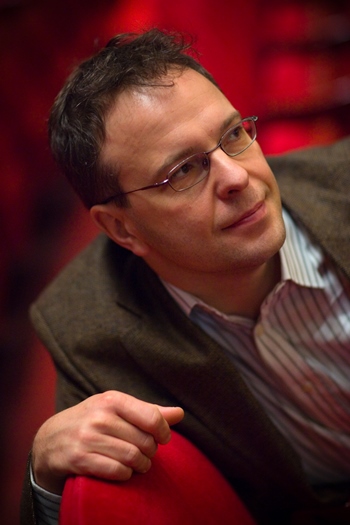Conductor Oramo, bringing Nielsen to CSO, sees master builder’s hand in 5th Symphony
 Preview: Finnish maestro Sakari Oramo will lead Chicago Symphony Orchestra in concerts April 4-6 at Orchestra Hall, with Yuja Wang as soloist in Prokofiev’s Piano Concerto No. 3.
Preview: Finnish maestro Sakari Oramo will lead Chicago Symphony Orchestra in concerts April 4-6 at Orchestra Hall, with Yuja Wang as soloist in Prokofiev’s Piano Concerto No. 3.
By Lawrence B. Johnson
When Finnish conductor Sakari Oramo steps in front of the Chicago Symphony Orchestra for concerts April 4-6, he will put the spotlight on Danish composer Carl Nielsen, who has waxed and waned in the hearts of audiences and conductors alike over the last half century.
 Oramo, chief conductor of the Stockholm Philharmonic and newly appointed principal conductor of the BBC Symphony, will lead Nielsen’s Fifth Symphony (1920-22), which the maestro characterizes as “difficult to fit into any box — a proof of its richness.”
Oramo, chief conductor of the Stockholm Philharmonic and newly appointed principal conductor of the BBC Symphony, will lead Nielsen’s Fifth Symphony (1920-22), which the maestro characterizes as “difficult to fit into any box — a proof of its richness.”
Nielsen himself has proved to be an elusive figure since he belatedly came to global attention in 1965, the birth centennial he shared with his ever-popular Finnish counterpart, Jean Sibelius. That coincident observance sparked a surge of interest in Nielsen, especially in his six symphonies, expressed through performances everywhere and a number of highly touted recordings.
It appeared that Nielsen, who died in 1931, might enjoy the same delayed but enduring popular embrace that raised Mahler to primacy in concert halls worldwide. But while his symphonies continue to crop up, the trajectory of Nielsen’s star has leveled off, not below the horizon but well beneath the high orbit or either Sibelius or Mahler.
“In my experience, his name when mentioned to concert promoters and orchestra programmers anywhere in Germany, France, Italy, Spain or Switzerland creates a mild panic,” says Oramo via email. “Only in the Nordic countries is he fairly regularly performed. Even the United Kingdom, which is very pro-Sibelius, has had little exposure to Nielsen since Sir Simon Rattle and I left the country.”
 Oramo succeeded Rattle as chief conductor of the City of Birmingham Symphony from 1998-2008. He made his Chicago Symphony debut in 2011 on short notice when he subbed for music director Riccardo Muti, who had collapsed during rehearsals from what proved to be heart arrhythmia.
Oramo succeeded Rattle as chief conductor of the City of Birmingham Symphony from 1998-2008. He made his Chicago Symphony debut in 2011 on short notice when he subbed for music director Riccardo Muti, who had collapsed during rehearsals from what proved to be heart arrhythmia.
Given the generally accessible make-up of Nielsen’s music, outright resistance to it defies understanding, says Oramo.
“Barring the Sixth Symphony, which is indeed strange, Nielsen (displays) an uncommonly tight grip on musical architecture and dramaturgy, a crisp harmonic language that shakes the boundaries of tonality but doesn´t venture (too far), and a near-perfect balance between emotion and intellect, melody and counterpoint, abstract form and philosophical strength, logical development and shock effect. His music has tremendous emotion that only comes out if left to happen by the natural forces.
“As a symphonist, Nielsen´s point of reference is the Haydn-Brahms pedigree (whereas) Sibelius is very much in the Beethovenian tradition, but also deeply affected by Wagner and Tchaikovsky, especially early on, and Debussy a little later. In Sibelius´ kaleidoscopic forms, the various elements converge. His motives are like seeds out of which grows a tree. Nielsen uses blocks of material which he collides with each other, creating conflict and contrast.”
Musical comparisons aside, Oramo says, the reason Nielsen has yet to work Sibelius’ magic on the public’s imagination may have more to do with extra-musical issues, what the conductor calls the Big Story:
“All this fight for a nation´s independence, becoming a young country´s symbol No. 1, heavy drinking and cigars, the gargantuan struggle with the musical material that characterize Sibelius are foreign to Nielsen, who composed with relative technical ease, but was deeply affected by the world around him and shows it in his music — Symphony No. 4 (‘Inextinguishable’) and Symphony No. 5.”
 Like the Third (“Sinfonia espansiva”) and Fourth Symphonies, the Nielsen Fifth has enjoyed a continuous presence, if not exactly a high profile, in the concert repertoire over the decades since the Nielsen’s “discovery” in the 1960s. Nielsen envisioned the two-movement work as a study in contrasts, Oramo says.
Like the Third (“Sinfonia espansiva”) and Fourth Symphonies, the Nielsen Fifth has enjoyed a continuous presence, if not exactly a high profile, in the concert repertoire over the decades since the Nielsen’s “discovery” in the 1960s. Nielsen envisioned the two-movement work as a study in contrasts, Oramo says.
“Material and anti-material, dark and light, good and evil, idle and active. The extraordinary drama created by the juxtaposition of the ‘good’ and ‘evil’ elements in the latter part of the first movement catapults the movement´s principal character — the side drum — completely off-course. When calm is restored with the consolatory clarinet solo, the drummer can be heard disappearing into the distance for good: he will never appear again. All this, and the traditionally military character of the instrument, makes one think on the First World War, which had ended only a couple of years before.
“After this enormous struggle, the second movement seems to roll unstoppably by the force of its own gravity. The evil isn´t there anymore in a recognizable form, but perhaps lingers among and inside us all in a new disguise. What could be more relevant to our own times?”
Related Links:
- Performance location, dates and times: Details at CSO.org
- Carl Nielsen timeline: Read it at nyphil.org
Photo captions and credits: Home page and top: Conductor Sakari Oramo (Photo by Heikki Tuuli) Descending: Composer Carl Nielsen. Conductor Sakari Oramo will lead Carl Nielsen’s Fifth Symphony with the CSO. Youtube video of Sakari Oramo conducting a rehearsal of Nielsen’s Symphony No. 1 with the Royal Stockholm Philharmonic. Conductor Sakari Oramo listens from the audience perspective.
Tags: Carl Nielsen, Chicago Symphony Orchestra, Sakari Oramo

